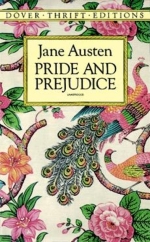 Pride and Prejudice
Pride and Prejudice
Jane Austen
England, 1813
My most recent reread of Pride and Prejudice (I believe this was my third time through Austen’s most famous novel) was over my September vacation, and I confess I wasn’t really reading it for anything other than pure enjoyment of the story. And it was a pure joy. I had forgotten quite how much I enjoy Austen’s writing and her tales; although I reread Northanger Abbey about a year previous, it was one of Austen’s earlier works and its charms are different than those of Pride and Prejudice.
(And from here, I assume you’ve read this or otherwise know the plot and don’t care about “spoilers.”)
But as I thought about it afterwards, I recognized that while on the surface–and this is perhaps the Austen we most commonly see in pop culture–Pride and Prejudice seems in many ways a fairy tale: poor(ish) girl + rich boy = happily ever after (in the case of P&P x 2), this is only the surface, and only the central characters. Elizabeth and Jane Bennett’s marriages to the wealthy Mr. Darcy and Mr. Bingley, respectively, may have all the elements of happily-ever-after, but even if we don’t question that supposition, there are two other weddings that happen in the course of the novel. To imagine that Lydia and Mr. Wickham will ever end happily…well. I can think of any number of outcomes, one of which Austen actually illustrates in Mr. and Mrs. Price in Mansfield Park – and that’s the best alternative. Let’s just say I imagine that Lydia will hardly be Mr. Wickham’s last conquest.
Without thinking highly either of men or of matrimony, marriage had always been her object; it was the only honourable provision for well-educated young women of small fortune, and however uncertain of giving happiness, must be their pleasantest preservative from want. (Ch. XXII)
And then there’s Charlotte Lucas and the ridiculous Mr. Collins – a marriage of pure practicality. And her reasonableness in entering into a wedded state with such an unreasonably silly man serves to illustrate to readers even centuries later just what the situation was for a woman of Austen’s era. No, the fairy tale may be the surface that pulls us in, but the reality that lies beneath is the reminder of just how fortunate the eldest sisters–and we today–really are.
So true that Austen contrasts the different marriages, and she causes the reader (or should cause the reader) to meditate on the important qualities in a spouse that will lead to a contented or discontented marriage. I like how she doesn’t water Mr. Darcy down and make him perfect. He still has his faults, but the deeper character traits that are crucial to have for happiness, are there to be “excavated”, shall we say.
I’m not certain that we are more fortunate today in some ways. Just because we are able to choose, does not mean that we choose well. Society puts pressure on women (and men) today as it did then, just perhaps in different ways. And if you notice, it is Mr. Bennett who is the loser in the Bennett marriage which made me think that Austen was not focusing on women particularly, but on character, treating both sexes equally in this case.
Yes, the marriage of Mrs. and Mr. Bennett offers us another example as well. I don’t think Austen makes anyone perfect (well…maybe Jane?)–both Elizabeth and Mr. Darcy have to grow in order to get to their “happy ending.”
Rereading my post, I find I left out half my thought–fortunate, I think, not because we are lacking pressure, but in that women typically no longer have to depend on marriage or the benevolence of relatives for survival. We can choose to be independent if we wish (or if necessity gives us no other path), an option not available to most women of Austen’s era.